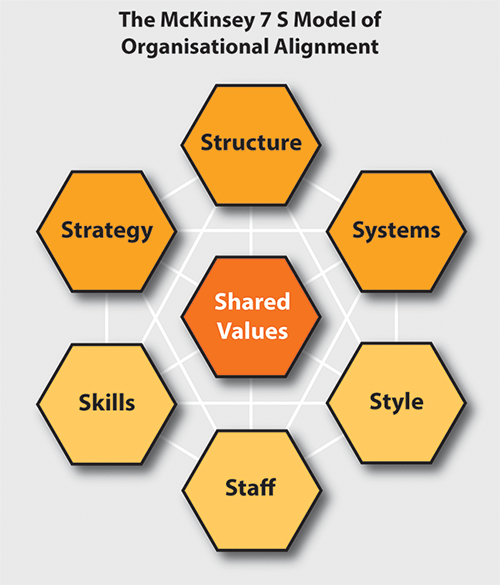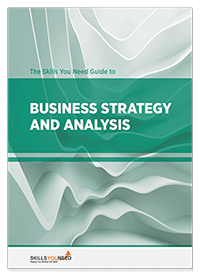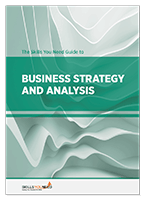The McKinsey 7 S Model
of Organisational Alignment
See also: PESTLE Analysis
The McKinsey 7 S model was developed in the 1980s by Tom Peters and Robert Waterman, who were working at the consulting firm McKinsey at the time.
The model examines the factors internal to the organisation that can affect its success. It is therefore a useful way of identifying strengths and weaknesses as part of a SWOT analysis.
The key to understanding and using the 7 S model is that the elements of the organisation should all be aligned or consistent. In other words, they should all be focused on achieving the same organisational outcomes and goals.
This page explains more about how to assess this by looking at different areas of the organisation.
The 7 S Model
The 7 S model considers seven elements of organisations, three ‘hard’ (strategy, structure and systems) and four ‘soft’ (shared values, skills, staff, and style), all of which are interrelated.
The model is often visualised as a sort of web, with shared values in the centre.

The 7 S model emerged from the realisation, revolutionary at the time, that organisations were considerably more than their structure.
This new understanding was seen to explain a good deal of the issues with failing organisational change, since many organisations set out to change their structure, and then wondered why this did not have more impact. This model set out to provide a way of looking at an organisation more holistically, across both implicit and explicit areas, and to try to identify all the elements that made up the organisation.
The model suggests that these seven elements must be aligned, or consistent. By looking at each element in turn, therefore, and gathering information about it, it is possible to identify whether any of the seven are out of line. Any potential lack of alignment may be preventing the organisation from achieving its stated objectives.
Seven Elements of Organisations
1. Strategy
Strategy is the organisation’s plan for the future, and how it will achieve sustainable competitive advantage
Many organisations publish details of their strategy, even if only internally. It is important to consider implicit as well as explicit strategy, however, including how the organisation deals with competitive pressure, and how it responds to changes in customer demand. The issue of how strategy adapts to external changes can be very informative as it says a lot about the implicit strategy of the organisation.
2. Structure
Structure is the organisational hierarchy, including reporting arrangements.
This area is very much the formal structure: the organisational chart. However, it should also include consideration of whether the formal structure fully sets out the power relationships (for example, are there junior members of the hierarchy who have considerably more power than would be expected?).
It may also be helpful to consider aspects like whether decision-making is centralised or decentralised, and the communication lines of the organisation, as these explain the implicit structure.
3. Systems
Systems includes all the processes and procedures used within the organisation
This element ranges from HR and pay systems to filing, email and other communication technology. It also includes both organisation-wide and team systems, especially if these are conflicting in some way. For example, sometimes official systems are too complicated or not up to the job, so teams have found a way round them: this is an important element of how the organisation works, and may affect the ability of teams to work together.
4. Shared Values
Shared values are the core values of the organisation, shown in the culture and general ‘feel’ of the organisation.
Shared values may be implicit or explicit, but are central to the organisation, which is why they are placed in the middle of the ‘web’. Everything else emerges from them. The shared values are likely to be linked to the purpose of the firm, or the vision of the founders, or an understanding about why the organisation exists.
Organisational members should all be able to articulate the shared values of their team and the organisation, including the ‘feel’ of the organisation, and whether this has changed recently. It is likely to be a problem if the team and organisational values conflict in some way.
The importance of shared values
There is a story about a visitor to NASA during the 1960s asking a janitor what he did in the organisation.
He answered ‘I’m helping to put a man on the moon’.
This story is probably apocryphal (because why would anyone ask a janitor what he did), but it serves to illustrate the importance of shared values.
5. Style
Style describes the style of leadership in the organisation
There are many different styles of leadership (and for more about this, you may like to read our page on Leadership Styles). All of them have a different effect on the organisation and its members, and it is worth exploring the nature of the leadership style of the whole leadership team, not just the CEO.
It is also worth considering whether there is (or needs to be) genuine team-working, or simply groups working together. For more about this, see our pages on Working in Teams and Groups.
6. Staff
Staff describes the organisation’s employees and their general characteristics
This will include issues like demographics and diversity, and therefore whether the organisation is drawing on the widest possible talent pool. It should also consider ways of working, and whether the organisation enables and supports remote and part-time working, and other flexible practices.
It also, however, includes issues like turnover and whether posts remain unfilled for any length of time, as this gives information about the way the organisation is seen, and how it treats its employees.
7. Skills
Skills describes the employees’ competences and capabilities
This element considers the employees’ existing skills and competences, and how they are developed. It also, however, covers how skills are assessed and monitored, and any gaps identified and filled. It can also be helpful to consider what the organisation or team has a reputation for doing well and badly.
Further Reading from Skills You Need
The Skills You Need Guide to Business Strategy and Analysis
Based on our popular management and analysis content the Skills You Need Guide to Business Strategy and Analysis is a straightforward and practical guide to business analysis.
This eBook is designed to give you the skills to help you understand your business, your market and your competitors.
It will help you understand why business analysis is important for strategy—and then enable you to use analytical tools effectively to position your business.
Analysis is only the start
The McKinsey 7 S model is a very good way of examining an organisation, and identifying elements that may not be contributing effectively to success. It is therefore a useful tool for using in a SWOT (Strengths, Weaknesses, Opportunities, Threats) analysis, to identify the strengths and weaknesses. As with any tool, however, the analysis, and identifying potential problems and solutions, is only the start.
The next step is to do something about it, and for that, you may want to read our pages on Strategic Thinking, Action Planning, and Change Management.


